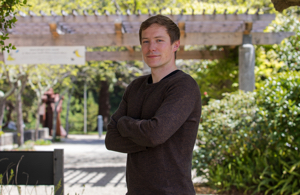At the onset of the COVID–19 pandemic, it became clear that there was a need for quality, up-to-date data about the spread of the virus.
UC Santa Cruz turned to Institutional Research, Assessment and Policy Studies for help to create a dashboard that would provide frequent updates for the campus community. Ole Kupsch and Leo Rosen, two analysts in the department, teamed up to make it happen.
Until that time, both had been focusing on analyzing data related to enrollment and grades. Though neither had worked in the health field before, they knew they had the skills to make effective dashboards and interactive data portals.
It was one of the most important jobs they had ever worked on.
“We expect politicians and administrators to make decisions not based on a gut feel or something you think is right or anecdotal evidence,” Kupsch said. “It’s supposed to be data-driven.”
Working with health statistics came with new rules. Because of health privacy laws, the analysts could only work with aggregated data sets. As an example, they were not allowed to see who got a positive COVID–19 test or whether the person was male or female. They saw the same data that the public ultimately saw in the dashboard they created. The analysts worked to structure the data and put it in a more visually appealing format.
Rosen took the lead in creating the dashboard on the “Roadmap to Recovery” website. Working in collaboration with the university’s Molecular Diagnostic Lab and campus leadership, he crafted a portal that included the number of COVID–19 cases related to the university, the test positivity rate, the number of students in quarantine or isolation and other information. Rosen said it took a little more than a month to get the first version of the site up after he began the project in September.
Rosen said the experience gave him respect for what the lab was able to accomplish in such a short time. With UC Santa Cruz not having a medical school, it fell to the lab to set up a COVID–19 testing site.
“Without them doing the testing, there would be no data,” Rosen said.
Like everyone else, Rosen and Kupsch had to work on the dashboard while dealing with all the other disruptions in their lives because of pandemic restrictions. Both had to leave their office and do the work from home.
Rosen said he really misses being able to see people in person and easily ask his colleagues questions about anything that comes up. He much prefers actual physical conversations over emails or Zoom calls.
“I’m ready to go back to the office and see people,” he said. “I’m looking forward to that day.”
Kupsch is more comfortable working from home, though he too misses the interaction with colleagues. He said the most difficult part of the pandemic for him has been that he and his wife haven’t been able to visit their families in Germany.
Both Rosen and Kupsch are grateful to have been able to help the campus manage COVID–19 and to learn about different departments in the university.
“What was really cool about this was being able to work with the folks from the student health service and folks who run the testing site,” Kupsch said, adding that he usually just works with people in his field. “This was something completely new.”




